
Miyakejima is a volcanic island whose shape is almost elliptical, with a circumference of nearly 38 km and with an area of nearly 55 ㎢. The island is located about 180 km south-southwest of Tokyo metropolitan area, and on the Pacific Ocean about 80 km off Izu-hanto peninsula, the nearest land.
It has a warm and pluvial climate influenced by the Japan Current, with an annual mean temperature of 17.5℃, 9.4℃ in the coldest month (February) and 25.8℃ in the warmest month (August). Its annual rainfall exceeds 3,000 mm.
It is windy throughout the year and there are as many as about 230 days when the wind blows at the rate of over 10 m/s. From April to September there are strong southwest winds, and from October to March there are strong west winds.
The population of Miyakejima is about 2,400 (as of April 2019). They make a living mainly by agriculture, fishery and tourism.
Miyakejima is designated as an IBA (Important Bird Areas) by Wild Bird Society of Japan. IBA is a project of BirdLife International, an international organization for bird conservation whose headquarter is located in Cambridge UK, in collaboration with its affiliated groups including WBSJ in more than 100 countries throughout the world. The reason for the IBA designation of Miyakejima is that it has one worldwide endangered species -Japanese Night Heron MIZOGOI Gorsachius goisagi, whose breeding has not been confirmed, four vulnerable species, Japanese Murrelet KANMURI-UMISUZUME Synthliboramphus wumizusume, Izu Thrush AKAKOKKO Turdus celaenops, Pleske's Grasshopper-warbler UCHIYAMA-SENNYU Locustella pleskei and Izu Leaf-warbler IIJIMA-MUSHIKUI Phylloscopus ijimae, and three highly endemic species , Japanese Wood-pigeon KARASU-BATO Columba janthina, Izu Thrush and Izu Leaf-warbler.
Miyakejima is well known for its high density of wild birds and for wild birds being very close to humans. You can see a Japanese endemic species, Izu Thrush, as well as subspecies of Varied Tit O-SUTON-YAMAGARA Parus varius owstoni and subspecies of Japanese Robin TANE-KOMADORI Erithacus akahige tanensis, which evolved uniquely in the island, and Izu Leaf-warbler, Pleske's Grasshopper-warbler and Japanese Wood-pigeon, whose distribution is limited. So far, about 280species of wild birds have been recorded there.
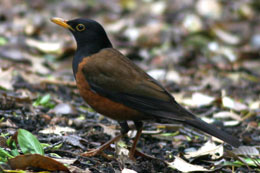 |
 |
| Izu Thrush - National Natural Treasure, Endangered (EN) | Izu Leaf-warbler - National Natural Treasure, Vulnerable (VU) |
At the foot of the mountain from the north to the northwest and in the south of the island extend precious evergreen broadleaf forests consisting of SUDAJII Castanopsis cuspidate, TABUNOKI Machilus thunbergii and so on. Due to the volcanic activities started in June 2000, the vegetation was largely destroyed, which made the mountain surface bare at an altitude above around 450 meters. Besides, mainly in the east and the southwest of the island, you can see trees killed by the volcanic gas from the summit crater.
The plants in Miyakejima which grow first in the bare land created by volcanic activities include HACHIJOITADORI Fallopia japonica var. hachidyoensis and OBA-YASHABUSHI Alnus sieboldiana Matsumura. They are followed by some plants like HACHIJO-KIBUSHI Stachyurus praecox var. matsuzaki and OBA-EGONOKI Styrax japonica var. kotoensis. Then, after a long period of time, the vegetation turns into evergreen broadleaf forests consisting of SUDAJII
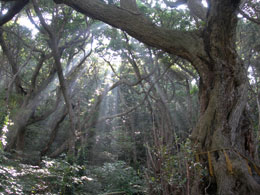 |
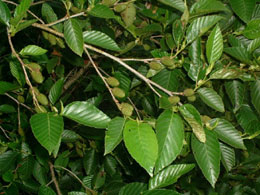 |
| SUDAJII | OBA-YASHABUSHI |
In the sea, you can see saltwater fish from the south owing to the Japan Current. From spring to fall, saltwater fish born in the southern sea such as Orbicular batfish NANYO-TSUBAMEUO Platax orbicularis, Surge demoiselle MIYAKO-KISENSUZUMEDAI Chrysiptera leucopoma, etc. are carried there on the Japan Current. Some rare fish which characterize the area including Japanese angelfish RENTEN-YAKKO Centropyge interrupta, Moyer's dragonet MIYAKE-TEGURI Neosynchiropus moyeri, Moyer's leopard-wrasse USUBA-NODOGUROBERA Macropharyngodon moyeri also live there. Besides, there are as many as about 90 species of coral, thus a huge variety of marine life can be observed.
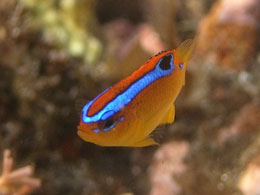 |
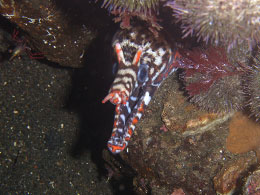 |
| MIYAKO-KISENSUZUMEDAI | TORAUTSUBO |
In Miyakejima, you can see unique landforms created by volcanic activities everywhere. There are "Tairoike", a crater lake created by the volcanic activities about 2,500 years ago, "Shinmyoike-ato", a trace of an explosion crater-, "Hyotanyama", a hill created by the volcanic eruptions in 1940-, "Kyu-akoshochugakko-ato", a trace of the former Ako Elementary and Junior High School buried under lava by the eruptions of 1983, and so on. By the eruptions of July 2000, a huge pit crater with a diameter of about 1.6km was created on the top of Mt. Oyama (814m in altitude at that time) covered with green vegetation, and the altitude of the mountain decreased to about 775 m. It shows us the tremendous volcanic activities and the immense power of nature.
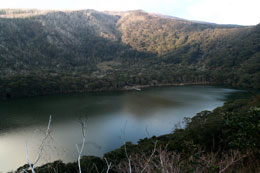 |
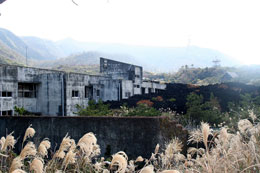 |
| Tairoike | Kyu-akoshochugakko-ato |